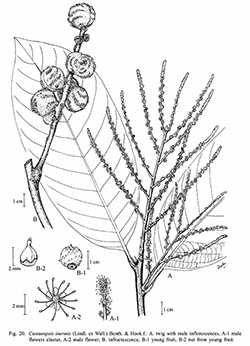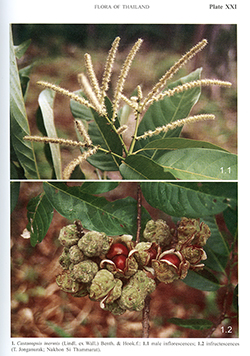e-Flora of Thailand
Volume 9 > Part 3 > Year 2008 > Page 213 > Fagaceae > Castanopsis
17. Castanopsis inermis (Lindl. ex Wall.) Benth. & Hook.f.wfo-0000814096
Gen. Pl. 3: 409. 1880; A.Camus, Chataigniers: 447, t.63. 1930; Corner, Wayside Trees Mal. 292, f.93, pl. 219. 1940; Barnett, Quer. Rel. Fag. Asia: 185. 1940; Trans. & Proc. Bot. Soc. Edinburgh 34: 366. 1944; Soepadmo, Fl. Males., ser. I, 7: 315. 1972.— Castanea inermis Lindl. ex Wall., Pl. Asiat. Rar. 2: 6. 1831; A.DC. Prodr. 16.2: 116. 1864. Fig. 20; Plate XXI.
Accepted Name : This is currently accepted.
Synonyms & Citations :
Description : Tree, 9–20 m high, 40–150 cm girth. Terminal buds ovoid-ellipsoid, ca 3 by 5 mm, scales ovate, acute, ca 5 by 2 mm, pubescent outside. Twigs pubescent then glabrous, sparsely lenticellate, blackish when dry. Bark ca 2 cm thick, grey, shallowly reticulate fissured; inner bark dirty brown or whitish; sapwood white; heartwood brown. Stipules triangular, ca 1 mm, caducous. Leaves obovate, obovate-oblong, oblong or lanceolate, 7–17 by 5–7 cm; base slightly cuneate, obtuse; apex acute or obtuse; margins entire or sometimes serrate; subcoriaceous, glabrous, glossy green on the upper surface and pubescent then glabrescent on the lower; midrib prominent on the lower surface and depressed on the upper; lateral nerves 7–12 pairs, distinct on the lower surface and slightly depressed on the upper, scalariform and reticulate veins hardly distinct. Petiole 1–1.5 cm, glabrous. Inflorescences male and female mixed or separate, terminal or axillary, pubescent. Male inflorescence always branched, spikelets 10–15 cm; bracts and bracteoles ovate, acute, ca 0.5 by 0.5 mm, tomentose outside. Male flowers white to yellowish, scented, usually in 3-flowered cluster; calyx 6-lobed, lobes free, obovate, ca 1 by 0.5 mm, glabrous, stamens 12, 2–3 mm long; rudimentary ovary ovoid, flattened on top, ca 1 mm in diam., hirsute. Female inflorescence always spike 10–15 cm long. Female flowers solitary or in 1–3–5-flowered cluster, other characters as in male flowers; styles 3, divergent, hairy near base; stigmata pointed. Fruits sessile, irregularly globose, 1.5–2.5 by 1.5–3.5 cm (including cupule), on erect and woody infructescence 15–20 cm long. Cupule completely enclosing the nut except the umbo and more or less fused with nut; wall sparsely covered with simple, short, curled spines set in 3–5 lines. Nuts (1)–2–3 per cupule, ovoid, ca 1 by 1 cm, usually emarginate at apex.
Thailand : NORTHERN: Chiang Mai, Nan; NORTH-EASTERN: Nakhon Phanom; EASTERN: Nakhon Ratchasima; PENINSULAR: Surat Thani, Krabi, Nakhon Si Thammarat, Phatthalung, Trang, Songkhla, Narathiwat.
Distribution : Burma, Malaysia, Singapore (type), Indonesia, the Philippines.
Ecology : Tropical evergreen rain forests, often near streams, on limestone and granite bedrock, 80–200 m (most commonly 80–100 m). Flowering: January–November (most commonly January–March); fruiting: June–December (most commonly June August).
Vernacular : Ko dueai (ก่อเดือย)(Northeastern); ko herm (ก่อเหิม)(Northeastern); ko mu (ก่อหมู), ko khao (ก่อข้าว), ko ta mu (ก่อตาหมู), konam (ก่อหนาม)(Peninsular).
Uses: Nuts edible.


